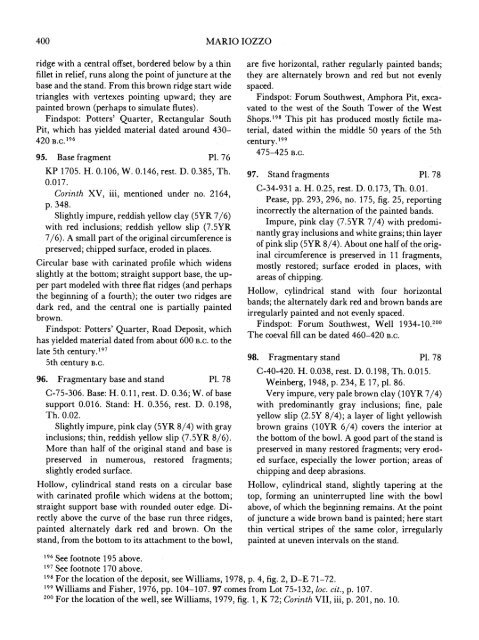f - The American School of Classical Studies at Athens
f - The American School of Classical Studies at Athens
f - The American School of Classical Studies at Athens
You also want an ePaper? Increase the reach of your titles
YUMPU automatically turns print PDFs into web optimized ePapers that Google loves.
400 MARIO IOZZO<br />
ridge with a central <strong>of</strong>fset, bordered below by a thin<br />
fillet in relief, runs along the point <strong>of</strong> juncture <strong>at</strong> the<br />
base and the stand. From this brown ridge start wide<br />
triangles with vertexes pointing upward; they are<br />
painted brown (perhaps to simul<strong>at</strong>e flutes).<br />
Findspot: Potters' Quarter, Rectangular South<br />
Pit, which has yielded m<strong>at</strong>erial d<strong>at</strong>ed around 430-<br />
420 B.C.196<br />
95. Base fragment P1. 76<br />
KP 1705. H. 0.106, W. 0.146, rest. D. 0.385, Th.<br />
0.017.<br />
Corinth XV, iii, mentioned under no. 2164,<br />
p. 348.<br />
Slightly impure, reddish yellow clay (5YR 7/6)<br />
with red inclusions; reddish yellow slip (7.5YR<br />
7/6). A small part <strong>of</strong> the original circumference is<br />
preserved; chipped surface, eroded in places.<br />
Circular base with carin<strong>at</strong>ed pr<strong>of</strong>ile which widens<br />
slightly <strong>at</strong> the bottom; straight support base, the up-<br />
per part modeled with three fl<strong>at</strong> ridges (and perhaps<br />
the beginning <strong>of</strong> a fourth); the outer two ridges are<br />
dark red, and the central one is partially painted<br />
brown.<br />
Findspot: Potters' Quarter, Road Deposit, which<br />
has yielded m<strong>at</strong>erial d<strong>at</strong>ed from about 600 B.C. to the<br />
l<strong>at</strong>e 5th century.197<br />
5th century B.C.<br />
96. Fragmentary base and stand P1. 78<br />
C-75-306. Base: H. 0.11, rest. D. 0.36; W. <strong>of</strong> base<br />
support 0.016. Stand: H. 0.356, rest. D. 0.198,<br />
Th. 0.02.<br />
Slightly impure, pink clay (5YR 8/4) with gray<br />
inclusions; thin, reddish yellow slip (7.5YR 8/6).<br />
More than half <strong>of</strong> the original stand and base is<br />
preserved in numerous, restored fragments;<br />
slightly eroded surface.<br />
Hollow, cylindrical stand rests on a circular base<br />
with carin<strong>at</strong>ed pr<strong>of</strong>ile which widens <strong>at</strong> the bottom;<br />
straight support base with rounded outer edge. Di-<br />
rectly above the curve <strong>of</strong> the base run three ridges,<br />
painted altern<strong>at</strong>ely dark red and brown. On the<br />
stand, from the bottom to its <strong>at</strong>tachment to the bowl,<br />
are five horizontal, r<strong>at</strong>her regularly painted bands;<br />
they are altern<strong>at</strong>ely brown and red but not evenly<br />
spaced.<br />
Findspot: Forum Southwest, Amphora Pit, exca-<br />
v<strong>at</strong>ed to the west <strong>of</strong> the South Tower <strong>of</strong> the West<br />
Shops.198 This pit has produced mostly fictile ma-<br />
terial, d<strong>at</strong>ed within the middle 50 years <strong>of</strong> the 5th<br />
century.'199<br />
475-425 B.C.<br />
97. Stand fragments P1. 78<br />
C-34-931 a. H. 0.25, rest. D. 0.173, Th. 0.01.<br />
Pease, pp. 293, 296, no. 175, fig. 25, reporting<br />
incorrectly the altern<strong>at</strong>ion <strong>of</strong> the painted bands.<br />
Impure, pink clay (7.5YR 7/4) with predomi-<br />
nantly gray inclusions and white grains; thin layer<br />
<strong>of</strong> pink slip (5YR 8/4). About one half <strong>of</strong> the orig-<br />
inal circumference is preserved in 11 fragments,<br />
mostly restored; surface eroded in places, with<br />
areas <strong>of</strong> chipping.<br />
Hollow, cylindrical stand with four horizontal<br />
bands; the altern<strong>at</strong>ely dark red and brown bands are<br />
irregularly painted and not evenly spaced.<br />
Findspot: Forum Southwest, Well 1934-10.200<br />
<strong>The</strong> coeval fill can be d<strong>at</strong>ed 460-420 B.C.<br />
98. Fragmentary stand P1. 78<br />
C-40-420. H. 0.038, rest. D. 0.198, Th. 0.015.<br />
Weinberg, 1948, p. 234, E 17, pl. 86.<br />
Very impure, very pale brown clay (1OYR 7/4)<br />
with predominantly gray inclusions; fine, pale<br />
yellow slip (2.5Y 8/4); a layer <strong>of</strong> light yellowish<br />
brown grains (10YR 6/4) covers the interior <strong>at</strong><br />
the bottom <strong>of</strong> the bowl. A good part <strong>of</strong> the stand is<br />
preserved in many restored fragments; very erod-<br />
ed surface, especially the lower portion; areas <strong>of</strong><br />
chipping and deep abrasions.<br />
Hollow, cylindrical stand, slightly tapering <strong>at</strong> the<br />
top, forming an uninterrupted line with the bowl<br />
above, <strong>of</strong> which the beginning remains. At the point<br />
<strong>of</strong> juncture a wide brown band is painted; here start<br />
thin vertical stripes <strong>of</strong> the same color, irregularly<br />
painted <strong>at</strong> uneven intervals on the stand.<br />
196 See footnote 195 above.<br />
197 See footnote 170 above.<br />
198 For the loc<strong>at</strong>ion <strong>of</strong> the deposit, see Williams, 1978, p. 4, fig. 2, D-E 71-72.<br />
199 Williams and Fisher, 1976, pp. 104-107. 97 comes from Lot 75-132, loc. cit., p. 107.<br />
200 For the loc<strong>at</strong>ion <strong>of</strong> the well, see Williams, 1979, fig. 1, K 72; Corinth VII, iii, p. 201, no. 10.

















